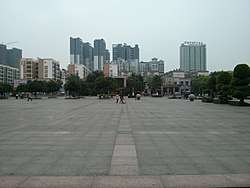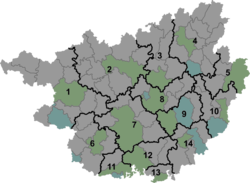Liujiang District
Liujiang District (simplified Chinese: 柳江区; traditional Chinese: 柳江區; pinyin: Liǔjiāng Qū; Standard Zhuang: Liujgyangh Gih) is under the administration of Liuzhou, Guangxi Zhuang Autonomous Region, China, located on the southwest bank of the Liu River. It covers a land area of 2,504 square kilometres (967 sq mi) and had a population of 562,351 as of 2010. The southernmost county-level division of Liuzhou City, it lies south of Liuzhou's city proper, bordering the prefecture-level cities of Laibin to the south and Hechi to the northwest.
Liujiang 柳江区 · Liujgyangh Gih | |
|---|---|
District | |
 | |
 Liujiang Location in Guangxi | |
| Coordinates: 24°15′25″N 109°20′13″E[1] | |
| Country | People's Republic of China |
| Autonomous region | Guangxi |
| Prefecture-level city | Liuzhou |
| Subdivisions | 11 towns 1 township |
| Seat | Labao (拉堡镇) |
| Area | |
| • Total | 2,504 km2 (967 sq mi) |
| Elevation | 110 m (360 ft) |
| Population (2010)[3] | |
| • Total | 562,351 |
| • Density | 220/km2 (580/sq mi) |
| Time zone | UTC+8 (China Standard) |
| Postal code | 5451XX |
Administrative divisions
Liucheng consists of 11 towns and 1 township:[4]
Towns:
- Labao (拉堡镇), Liyong (里雍镇), Baipeng (百朋镇), Chengyuan (成团镇), Luoman (洛满镇), Liushan (流山镇), Sandu (三都镇), Ligao (里高镇), Jiangde (进德镇), Chuanshan (穿山镇), Shibo (土博镇)
The only township in the Baisha Township (白沙乡)
Transportation
Rail
- Guizhou–Guangxi Railway
Liujiang hominid
These findings might give some support to the claim that modern humans from Africa arrived at southern China about 100,000 years BP (Zhiren Cave, Chongzuo City: 100,000 years BP;[5][6][7] and the Liujiang hominid: controversially dated at 139,000–111,000 years BP [8]).
Climate
| Climate data for Liujiang (1981−2010) | |||||||||||||
|---|---|---|---|---|---|---|---|---|---|---|---|---|---|
| Month | Jan | Feb | Mar | Apr | May | Jun | Jul | Aug | Sep | Oct | Nov | Dec | Year |
| Record high °C (°F) | 27.8 (82.0) |
33.2 (91.8) |
34.5 (94.1) |
35.5 (95.9) |
36.4 (97.5) |
36.7 (98.1) |
39.0 (102.2) |
38.9 (102.0) |
38.1 (100.6) |
36.3 (97.3) |
32.7 (90.9) |
29.9 (85.8) |
39.0 (102.2) |
| Average high °C (°F) | 14.4 (57.9) |
16.0 (60.8) |
19.3 (66.7) |
25.0 (77.0) |
29.2 (84.6) |
31.4 (88.5) |
33.0 (91.4) |
33.5 (92.3) |
31.7 (89.1) |
27.7 (81.9) |
22.7 (72.9) |
17.7 (63.9) |
25.1 (77.2) |
| Daily mean °C (°F) | 10.4 (50.7) |
12.3 (54.1) |
15.6 (60.1) |
21.0 (69.8) |
24.9 (76.8) |
27.3 (81.1) |
28.4 (83.1) |
28.6 (83.5) |
26.7 (80.1) |
22.6 (72.7) |
17.4 (63.3) |
12.5 (54.5) |
20.6 (69.2) |
| Average low °C (°F) | 7.6 (45.7) |
9.7 (49.5) |
12.9 (55.2) |
18.0 (64.4) |
21.6 (70.9) |
24.2 (75.6) |
25.1 (77.2) |
25.1 (77.2) |
23.0 (73.4) |
18.9 (66.0) |
13.7 (56.7) |
9.0 (48.2) |
17.4 (63.3) |
| Record low °C (°F) | −0.5 (31.1) |
0.2 (32.4) |
0.9 (33.6) |
7.8 (46.0) |
12.2 (54.0) |
16.5 (61.7) |
19.5 (67.1) |
20.5 (68.9) |
14.8 (58.6) |
8.1 (46.6) |
3.2 (37.8) |
−1.6 (29.1) |
−1.6 (29.1) |
| Average precipitation mm (inches) | 52.5 (2.07) |
59.6 (2.35) |
90.9 (3.58) |
129.4 (5.09) |
226.0 (8.90) |
288.2 (11.35) |
216.9 (8.54) |
175.2 (6.90) |
77.4 (3.05) |
57.8 (2.28) |
53.2 (2.09) |
34.9 (1.37) |
1,462 (57.57) |
| Average relative humidity (%) | 75 | 78 | 80 | 80 | 79 | 82 | 81 | 79 | 74 | 72 | 72 | 71 | 77 |
| Source: China Meteorological Data Service Center | |||||||||||||
References
- Google (2014-07-02). "Liujiang" (Map). Google Maps. Google. Retrieved 2014-07-02.
- Liuzhou City Land Use Plan (2006–20)/《柳州市土地利用总体规划(2006-2020年)》.(in Chinese) Accessed 8 July 2014.
- 《中国2010年人口普查分县资料》 (in Chinese). 中国统计出版社. December 2012. ISBN 978-7-5037-6659-6.
- 2011年统计用区划代码和城乡划分代码:柳江县 (in Chinese). National Bureau of Statistics of the People's Republic of China. Retrieved 2013-01-03.
- Liu, W.; Jin, C.-Z.; Zhang, Y.-Q.; Cai, Y.-J.; Xing, S.; Wu, X.-J.; Cheng, H.; Edwards, R. L.; Pan, W.-S.; Qin, D.-G.; An, Z.-S.; Trinkaus, E.; Wu, X.-Z. (25 October 2010). "Human remains from Zhirendong, South China, and modern human emergence in East Asia". Proceedings of the National Academy of Sciences. 107 (45): 19201–19206. doi:10.1073/pnas.1014386107. PMC 2984215. PMID 20974952. Lay summary.
- Dennell, Robin (24 November 2010). "Early Homo sapiens in China". Nature. 468 (7323): 512–513. doi:10.1038/468512a. PMID 21107416.
- "Oldest Modern Human Outside of Africa Found". National Geographic News. 25 October 2010.
- Shena, Guanjun; et al. (2002). "U-Series dating of Liujiang hominid site in Guangxi, Southern China". Journal of Human Evolution. 43 (6): 817–829. doi:10.1006/jhev.2002.0601. PMID 12473485.
External links